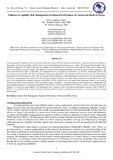Please use this identifier to cite or link to this item:
http://ir-library.mmust.ac.ke:8080/xmlui/handle/123456789/2269Full metadata record
| DC Field | Value | Language |
|---|---|---|
| dc.contributor.author | Amira, Edwin Ambetsa | - |
| dc.contributor.author | Alala, Benedict Ondiek | - |
| dc.contributor.author | Musiega, Maniagi | - |
| dc.date.accessioned | 2023-09-12T11:54:04Z | - |
| dc.date.available | 2023-09-12T11:54:04Z | - |
| dc.date.issued | 2023-07-05 | - |
| dc.identifier.uri | https://doi.org/10.51867/ajernet.4.2.3 | - |
| dc.identifier.uri | https://ajernet.net/ojs/index.php/ajernet/article/view/70 | - |
| dc.identifier.uri | http://ir-library.mmust.ac.ke:8080/xmlui/handle/123456789/2269 | - |
| dc.description.abstract | The management of liquidity risk in commercial banks determines the banks' financial performance, which predominantly influences the quality of the loan portfolio and the nature of credit administration programs as a whole. By ensuring that liquidity risk is effectively managed, the primary objective of liquidity risk management is to generate a high-quality, stable, large, and growing flow of net interest income for banks. This objective is achieved by ensuring that banks can meet the needs of their customers. This study determined the effect of liquidity risk management on the financial performance of Kenyan commercial banks. The investigation was founded on the theory of liquidity management shiftability. The paradigm of Positivism served as the philosophical foundation for the investigation. The study incorporated both explanatory and longitudinal research designs into its methodology. The study's target population consisted of 32 Commercial Banks in Kenya. The study utilized panel data consisting of time series and cross-sectional data spanning a decade from 2010 to 2019. Using Eviews, descriptive and inferential statistics were used to analyze the collected data, which was then presented in tables and figures. The study found out that Liquidity risk management had an insignificant negative relationship with ROE (F=0.583912, p<0.05) and ROA (F=2.770410, p<0.05). Arising from the study findings, it is observed that liquidity risk management has a negative effect on financial performance measure either in ROA or ROE, it is recommended that commercial banks should keep this parameter as minimum as possible so as not involve in loss making undertakings. | en_US |
| dc.language.iso | en | en_US |
| dc.publisher | African Journal of Empirical Research | en_US |
| dc.subject | Influence of Liquidity Risk Management on Financial Performance of Commercial Banks in Kenya | en_US |
| dc.title | Influence of Liquidity Risk Management on Financial Performance of Commercial Banks in Kenya | en_US |
| dc.type | Article | en_US |
| Appears in Collections: | Gold Collection | |
Files in This Item:
| File | Description | Size | Format | |
|---|---|---|---|---|
| Influence+of+Liquidity+Risk+Management+on+Financial+Performance+of+Commercial+Banks+in+Kenya+-+Amira+et+al..pdf | 389.46 kB | Adobe PDF |  View/Open |
Items in DSpace are protected by copyright, with all rights reserved, unless otherwise indicated.
